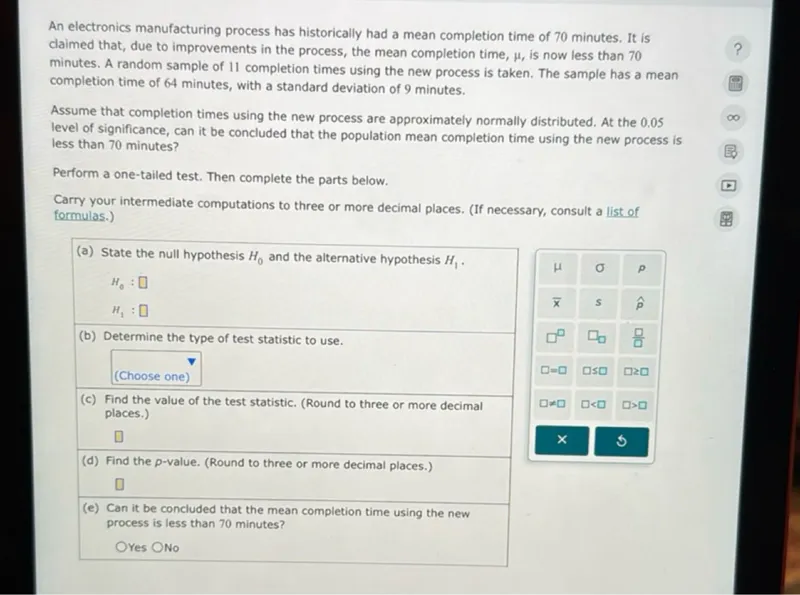Questions: An electronics manufacturing process has historically had a mean completion time of 70 minutes. It is claimed that, due to improvements in the process, the mean completion time, μ, is now less than 70 minutes. A random sample of 11 completion times using the new process is taken. The sample has a mean completion time of 64 minutes, with a standard deviation of 9 minutes. Assume that completion times using the new process are approximately normally distributed. At the 0.05 level of significance, can it be concluded that the population mean completion time using the new process is less than 70 minutes? Perform a one-tailed test. Then complete the parts below. Carry your intermediate computations to three or more decimal places. (If necessary, consult a list of formulas.) (a) State the null hypothesis H0 and the alternative hypothesis H1. H0: H1: (b) Determine the type of test statistic to use. (c) Find the value of the test statistic. (Round to three or more decimal places.) (d) Find the p-value. (Round to three or more decimal places.) (e) Can it be concluded that the mean completion time using the new process is less than 70 minutes? Yes No

Transcript text: An electronics manufacturing process has historically had a mean completion time of 70 minutes. It is claimed that, due to improvements in the process, the mean completion time, $\mu$, is now less than 70 minutes. A random sample of 11 completion times using the new process is taken. The sample has a mean completion time of 64 minutes, with a standard deviation of 9 minutes.
Assume that completion times using the new process are approximately normally distributed. At the 0.05 level of significance, can it be concluded that the population mean completion time using the new process is less than 70 minutes?
Perform a one-tailed test. Then complete the parts below.
Carry your intermediate computations to three or more decimal places. (If necessary, consult a list of formulas.)
(a) State the null hypothesis $H_{0}$ and the alternative hypothesis $H_{1}$.
\[
\begin{array}{l}
H_{0}: \square \\
H_{1}: \square
\end{array}
\]
(b) Determine the type of test statistic to use.
$\square$
(c) Find the value of the test statistic. (Round to three or more decimal places.)
$\square$
(d) Find the $p$-value. (Round to three or more decimal places.)
$\square$
(e) Can it be concluded that the mean completion time using the new process is less than 70 minutes?
Yes No





